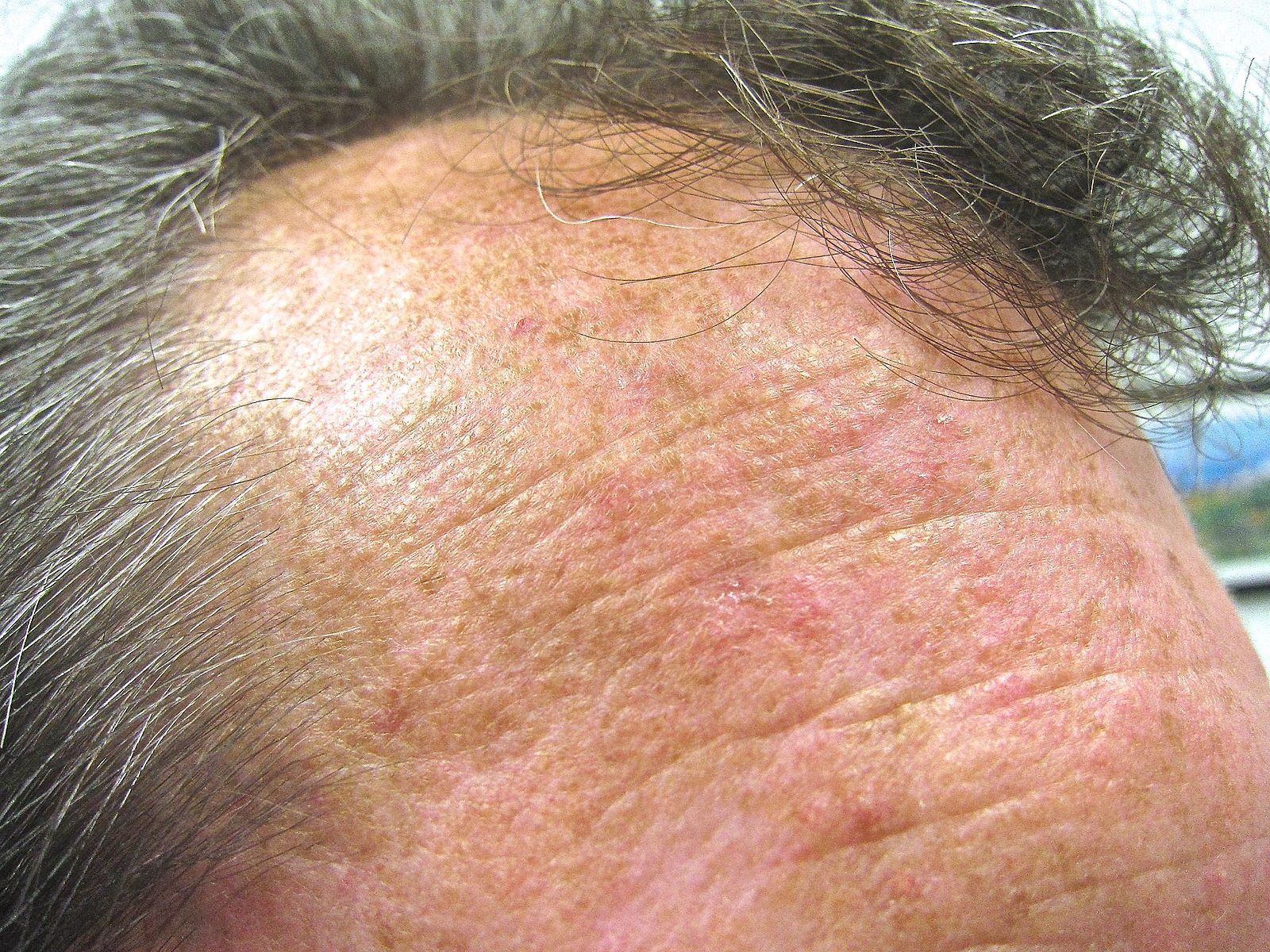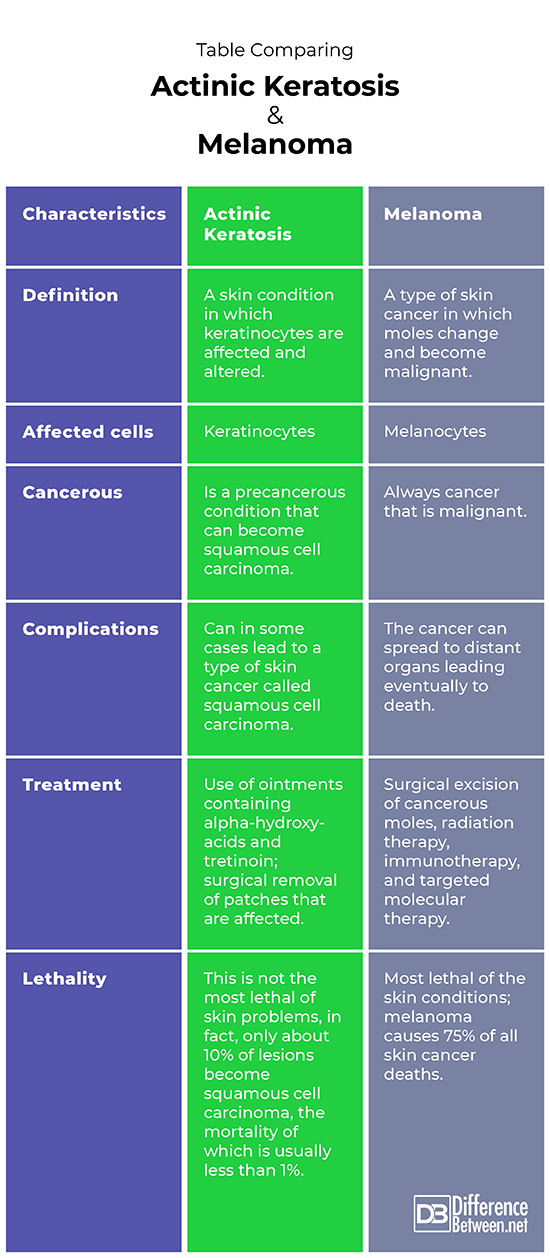Difference Between Actinic Keratosis and Melanoma
Actinic keratosis is a problem with epidermis of the skin in which lesions develop. Melanoma is an aggressive type of malignant skin cancer.

What is Actinic Keratosis?
Definition:
Actinic keratosis is a condition that happens where there are modifications in the epidermal keratinocytes.
Causes and prevalence:
The causative factor for actinic keratosis is exposure to UV radiation from the sun. The condition develops after a long time of exposure and sunburns, and it is most often a problem for people who have light skin and are in middle adulthood and old age.
Symptoms and complications:
Patches of skin become rough to the touch and scaly in appearance. They are usually small patches of dry area of skin that are less than 2.5 cm in diameter. These areas of skin that are affected can be pink to reddish or brownish in color and are usually found on parts of the body that get a lot of sun exposure, such as the face and arms. The condition is precancerous and can change into squamous cell carcinoma, a type of cancer.
Diagnosis:
Clinical examination of the skin and biopsy of skin lesions can positively diagnose this condition.
Treatment:
Affected regions of the skin can be treated with ointments containing alpha-hydroxy acids or the chemical tretinoin. The patches of skin can be excised by electrocautery and biopsied. Patients need to avoid future sun or tanning bed exposure that can cause the problem to continue or worsen. Sunblock can be used and sun protective clothing can be worn to protect the skin.

What is Melanoma?
Definition:
Melanoma is a cancer of the skin involving melanin—producing cells called melanocytes.
Causes and prevalence:
Exposure to ultraviolet radiation from years of sun exposure and/or the use of tanning beds can cause melanoma. The occurrence of melanoma has risen over recent years, sometimes by as much as 6%. Prevalence does vary by where a person lives with areas that receive more sunshine having more cases each year. Certain countries such as Australia and South Africa also have high melanoma rates due to the high levels of intense sunshine that they receive each year. While melanoma, like other types of skin cancer, is more common in older adults, young people in their twenties and thirties can be diagnosed with the condition.
Symptoms and complications:
Melanoma usually develops from a mole in the skin. The mole is brown in color, and over time it usually changes in color and becomes larger and irregular in shape, indicative of possible cancer. The mole may also feel itchy and bleed. Although the least common type of skin cancer, melanoma is the deadliest because it metastasizes easily to other organs in the body. Survival after 5 years varies from as high as 75% to as low as 25% depending on how much the cancer has spread.
Diagnosis:
A dermatologist takes a biopsy, usually from a suspicious looking mole. Microscopic examination of the skin tissue that was biopsied can indicate if the cells have changed, and are in fact, skin cancer.
Treatment:
Surgical removal of cancerous moles can be done, but often the cancer has already spread, which then necessitates the use of immunotherapy, molecular targeted therapy and radiation therapy.
Difference between Actinic keratosis and Melanoma?
Definition
Actinic keratosis isa skin condition in which keratinocytes are affected and altered. Melanoma is a type of malignant skin cancer in which a mole changes and becomes carcinogenic
Cells affected
In the case of actinic keratosis, the keratinocytes are affected. In the case of melanoma, the melanocytes are affected.
Cancerous
Actinic keratosis is a precancerous condition that can, in the future, become squamous cell carcinoma. Melanoma is a malignant skin cancer that easily spreads.
Complications
The main complication of actinic keratosis is that there is a risk it can develop into cancer. The complication of melanoma is that the cancer easily spreads to distant tissues and organs.
Treatment
The treatment of actinic keratosis involves the use of ointments containing alpha-hydroxy-acids and tretinoin and the surgical removal of patches that are affected. The treatment of melanoma involves the surgical excision of cancerous moles, radiation therapy, immunotherapy, and targeted molecular therapy.
Lethality
Actinic keratosis is not the most lethal of skin problems since only about 10% of lesions become squamous cell carcinoma, and then the mortality of this is usually less than 1%. Melanoma is a lethal skin condition, causing 75% of all skin cancer deaths.
Table comparing Actinic keratosis and Melanoma

Summary of Actinic keratosis Vs. Melanoma.
- Avoiding too much sun exposure, particularly if you have fair skin, is a way to help prevent both these skin problems.
- Actinic keratosis and melanoma both cause changes in the cells of the skin.
- Actinic keratosis is not as dangerous as melanoma since it is not cancer, but it can change into squamous cell carcinoma in some cases.
- Melanoma is malignant skin cancer which although the least common type of skin cancer, is also the deadliest.
- Difference Between Rumination and Regurgitation - June 13, 2024
- Difference Between Pyelectasis and Hydronephrosis - June 4, 2024
- Difference Between Cellulitis and Erysipelas - June 1, 2024
Search DifferenceBetween.net :
Leave a Response
References :
[0]Benedetti, Julia. “Overview of effects of sunlight”. Merckmanuals. Merck & Co., 2019,https://www.msdmanuals.com/professional/dermatologic-disorders/reactions-to-sunlight/overview-of-effects-of-sunlight
[1]Schadendorf, Dirk, et al. "Melanoma." Nature reviews Disease primers 1.1 (2015): 1-20.
[2]Wells, Gregory L. “Melanoma (Malignant Melanoma)”. Merckmanuals. Merck & Co., 2021, https://www.msdmanuals.com/home/skin-disorders/skin-cancers/melanoma
[3]Image credit: https://commons.wikimedia.org/wiki/File:519_Melanoma.jpg
[4]Image credit: https://commons.wikimedia.org/wiki/File:Actinic_keratoses_on_forehead.JPG
